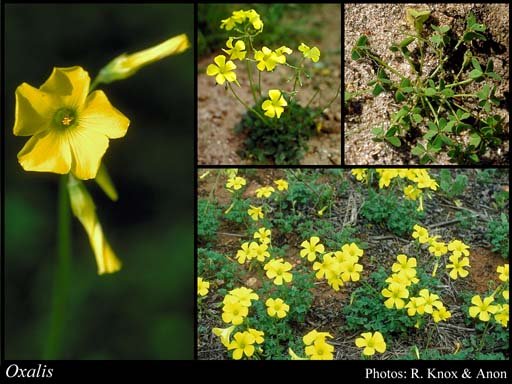- Reference
- Sp.Pl. [Linnaeus] 1:433 (1753)
- Name Status
- Current

Scientific Description
Family Oxalidaceae.
Habit and leaf form. Herbs. Annual, or perennial; plants with a basal concentration of leaves, or with neither basal nor terminal concentrations of leaves; bulbaceous, or rhizomatous, or tuberous. Helophytic, or mesophytic, or xerophytic. Leaves alternate; spiral; petiolate; non-sheathing; gland-dotted, or not gland-dotted; compound; ternate (usually; leaflets palmately arranged, folded downwards in repose). Leaflets often pulvinate (exhibiting ‘sleep movements’). Leaf blades pinnately veined. Leaves with stipules (sometimes conspicuous), or without stipules; without a persistent basal meristem. Vernation circinnate, or not circinnate. Leaf anatomy. Hydathodes present, or absent. Stem anatomy. Nodes tri-lacunar. Secondary thickening absent, or developing from a conventional cambial ring.
Reproductive type, pollination. Fertile flowers hermaphrodite. Unisexual flowers absent. Plants hermaphrodite. Plants heterostylous (mostly tristylous).
Inflorescence and flower features. Flowers solitary, or aggregated in ‘inflorescences’; in umbels. The terminal inflorescence unit cymose. Inflorescences axillary (on axillary or basal peduncles). Flowers bi- bracteate; small to large; regular; 5 merous; cyclic; tetracyclic to pentacyclic. Free hypanthium absent. Hypogynous disk present, or absent. Perianth of chasmogamous flowers with distinct calyx and corolla; 10; 2 -whorled; isomerous. Calyx 5; 1 -whorled; polysepalous; imbricate; regular; persistent. Corolla 5; 1 -whorled; gamopetalous (connate basally); contorted, or imbricate; regular; white, or pink, or red to purple, or yellow. Androecium 10. Androecial members free of the perianth; all equal, or markedly unequal (the outer whorl usually with shorter filaments); coherent; 1 - adelphous (the filaments basally connate); 2 -whorled. Stamens 10; diplostemonous; alternisepalous (the shorter, outer members opposite the petals). Anthers dorsifixed; dehiscing via longitudinal slits; introrse; tetrasporangiate. Gynoecium 5 carpelled. The pistil 5 celled. Carpels isomerous with the perianth. Gynoecium syncarpous; synovarious; superior. Ovary plurilocular; 5 locular (the lobes opposite the petals). Styles 5; free. Stigmas 5; 2 - lobed; dry type; papillate; Group II type. Placentation axile. Ovules 2–15 per locule (to ‘several’); pendulous; epitropous; arillate (often); anatropous, or hemianatropous.
Fruit and seed features. Fruit non-fleshy; dehiscent; a capsule. Capsules loculicidal (valves persistent on axis). Fruit elastically dehiscent (seeds with a fleshy axis which shrinks on drying and expels seeds explosively). Seeds usually copiously endospermic. Endosperm oily. Cotyledons 2. Embryo straight. Seedling. Germination phanerocotylar.
Geography, cytology, number of species. Native of Australia. Not endemic to Australia. Australian states and territories: Western Australia, South Australia, Northern Territory, Queensland, New South Wales, Victoria, Australian Capital Territory, and Tasmania. South-West Botanical Province.